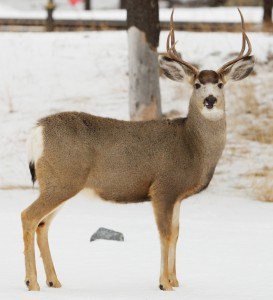
Canadian deer are becoming zombified by a self-perpetuating disease.
The disease is spreading westward and has the potential to end up on the doorstep of Jasper National Park.
It’s called chronic wasting disease, or more commonly mad deer disease. It causes the deterioration of a deer’s brain and nervous system, causing it to drool, stagger and become listless.
The disease is spread through the urine, scat, drool and other exudate of infected animals.
Kevin Van Tighem, a Canmore-based biologist and author of the award-winning book, Homeward Wolf, dedicated a chapter of his book to mad deer disease. He said it’s a relatively new disease, having first shown up in Colorado in the 1960s.
It was later brought to Canada when an infected elk was shipped from the United States to a Saskatchewan game farm. From there, the disease has been creeping its way westward.
“[Mad deer disease] started off in the Swift Current and Lloydminster area and it’s now most of the way to Edmonton and a good chunk of the way towards Calgary,” said Van Tighem, noting that “it’s spreading steadily.”
Although not an imminent danger for Jasper, Van Tighem said that under the right circumstances chronic wasting disease could easily make its way to the park boundary and beyond.
“There’s nothing standing between Jasper and the places where the disease is currently found, except geography and time. All things being equal, it will arrive.
“We’ve got an awful lot of deer, elk and moose in Alberta right now and that’s where that disease exists, so until we run out of those animals we’re going to be seeing that disease spread.”
Chronic wasting disease is spread through a deformed protein that’s manufactured in the body of the animal itself.
“So basically its a self-perpetuating disease. Once you’ve got it, you’re own body starts producing the infectious agent,” explained Van Tighem. So, the sicker the animal gets, the more deformed proteins—called prions—it produces, increasing the opportunity for other animals to come in contact with them, whether it’s through the infected animal’s drool, urine or droppings.
Historically, the disease has appeared in game farms, where large numbers of animals are crowded together into a small area, increasing the opportunity for infection.
The first wild Canadian deer discovered to have chronic wasting disease was shot by a hunter in 2005. Since that time, the Alberta government has started a program to check deer for the disease. The government encourages hunters to submit the head of their deer to be tested before the meat is consumed.
This is important, said Van Tighem, because there is a chance that eating an infected deer could put a person’s life at risk.
This is because chronic wasting disease falls in the same class of disease as mad cow disease—which killed dozens of people who ate infected cows in the 1990s.
“We’ve always been assured that these diseases don’t spread from the species they’re associated with to others, but mad cow disease did just that—it jumped to humans because humans ate parts of the infected animals,” explained Van Tighem.
“What I find even scarier is that the history of the disease has been associated with game farms and people buy game farm meat and they buy game farm velvet and they actually take capsules of velvet even though the velvet on the antler is one of the places that prions concentrate in infected animals.”
Van Tighem admits that the disease’s ability to jump from deer to humans is merely speculation at this point. But, looking at the history of mad cow disease, he said there’s evidence to prove it’s possible and that calls for concern.
One way to stop the spread of chronic wasting disease would be to maintain a healthy wolf population on the landscape, explained Van Tighem.
“Wolves are the ultimate defence. They’re out there all the time looking for vulnerable animals and chronic wasting disease makes animals vulnerable.
“Getting wolves to kill these animals before they become really sick and before they’ve had a chance to spread the prions makes all kinds of sense, but we tend to treat wolves as a problem and we try to minimize the number of wolves out there, so they’re not able to do the job.”
Van Tighem said the way chronic wasting disease is handled will be the “ultimate test, and we will know we failed the first time you see a drooling elk on the side of the highway in Jasper National Park.”
Nicole Veerman
[email protected]
